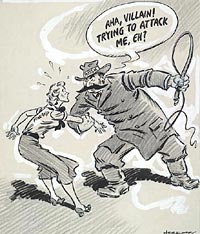

 During
the 1930s and 1940s, Herb Block was an early supporter of aid to England
and to European allies faced with Nazi aggression. He also supported measures
to prepare America for the struggle against aggression. He cited Nazi
outrages, giving them graphic form and visual power. He drew metaphors
for the resilience of the human spirit, the inhumanity of war, and the
duplicity of dictators.
During
the 1930s and 1940s, Herb Block was an early supporter of aid to England
and to European allies faced with Nazi aggression. He also supported measures
to prepare America for the struggle against aggression. He cited Nazi
outrages, giving them graphic form and visual power. He drew metaphors
for the resilience of the human spirit, the inhumanity of war, and the
duplicity of dictators.
Mr. Stalin revolutionizes the dramaIn 1939, Hitler's invasion of Poland precipitated World War II, and Russia joined in the dismemberment of that country. Emboldened by the Nazi-Soviet Pact of 1939 and wary of his new ally Germany, Stalin moved to extend his Eastern borders, annexing Latvia, Lithuania, Estonia, and part of Romania. When he made demands on Finland, however, the Finns resisted. On November 30, 1939, the Russians invaded, claiming Finnish forces had fired on Soviet troops. Finland put up a gallant and surprising defense, gaining the respect and admiration of the outside world, but was forced to agree to Russian terms in the spring of 1940. Mr. Stalin
revolutionizes the drama, 1939 |
|
|
|
|
Story of the last seven yearsIn the 1930s, the American public, recalling the losses of World War I, was loath to take seriously the menace posed by Hitler and his aggressive moves. Many Americans did not face up to the German threat even after the start of World War II when German troops overran much of Europe. Strong voices, including that of Charles Lindbergh, joined with "America First" organizations in asserting that the war was none of America's business; that England would fall anyhow; and that Hitler was not a menace. Through "lend-lease" and other measures Roosevelt aided England and increased American preparedness. Story of the
last seven years, May 1940 |
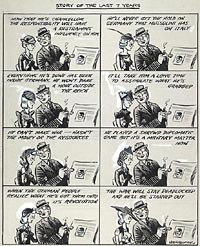 |
|
|
|
TravelogueDuring the "war in Europe" one of Herblock's most effective cartoons was this one, based on movie travelogues that ended with a farewell to the visiting country. Here the goodbye is in the picturing of countries that had fallen under Nazi rule. Travelogue,
1940 |
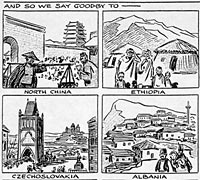 |
|
|
|
Herblock's own history of the
|
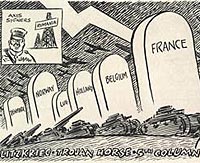
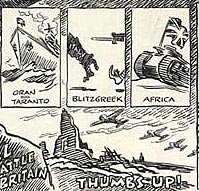
|
|
|
|
Working on himOne of the principal problems faced by Roosevelt and Churchill was the enormous toll of shipping sunk by German submarines. Working on him,
1941 |
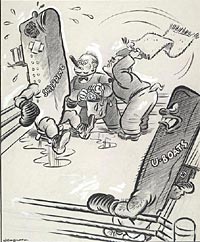 |
|
|
|
"Faster"Increasing the German birthrate was a top Nazi priority, even as Hitler sent more young men off to war. The Nazis instituted programs glorifying motherhood, providing financial incentives for those with large families, even encouraging "Aryan"-looking young women to bear children out of wedlock. "Faster",
April 17, 1941 |
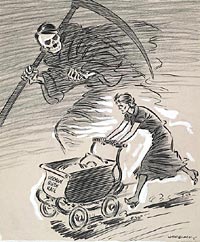
|
|
|
|
"Fifty-Fifty again, Joe?"Iran and Iraq were vital to both the Allies and the Axis during World War II, because of their location and their oil reserves. As part of the Nazi-Soviet Pact of 1939, Germany and the Soviet Union had agreed on the division of Eastern Europe, and might have contemplated a similar division in the Middle East. Hitler made other plans and on June 22, 1941, Germany invaded the Soviet Union. "Fifty-Fifty
again, Joe?" May 2, 1941 |
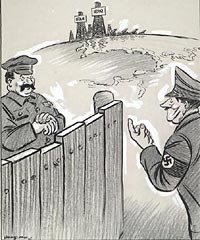 |
|
|
|
Sending forth another doveOn April 29, 1941, more than seven months before its attack on the United States, the Japanese government published an "exploratory" peace proposal to the United States. In a blatant attempt to gain American support for aggression by the Rome-Berlin-Tokyo-Axis, it called for a new world order that would carve out spheres of power. Germany and Italy would control Europe and Africa, Japan would control Asia, and the United States would control the Western Hemisphere. Sending forth
another dove, May 13, 1941 |
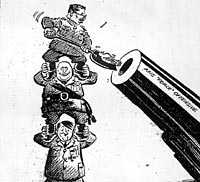 |
|
|
|
MussoliniWhen Italy's Fascist dictator, Benito Mussolini, came to power, he began proclaiming Italy's military superiority and building up his country's war machine. In 1935, in an uneven match, he invaded Ethiopia and later sent troops and planes to support Franco in the Spanish Civil War. With the advent of World War II, he hoped to emulate the military successes of his ally, Hitler. But his ventures in France, East Africa, North Africa, and particularly Greece met with crushing failure, and he required rescue by Nazi forces. In a speech on February 23, 1941, Mussolini blamed defeats in Libya on the fact that the British attacked before he was ready to launch his own offensive. Mussolini,
1941 |
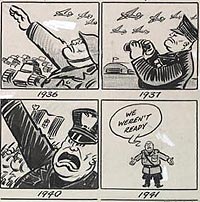 |
Library of Congress Help Desk ( November 9, 2001 )
